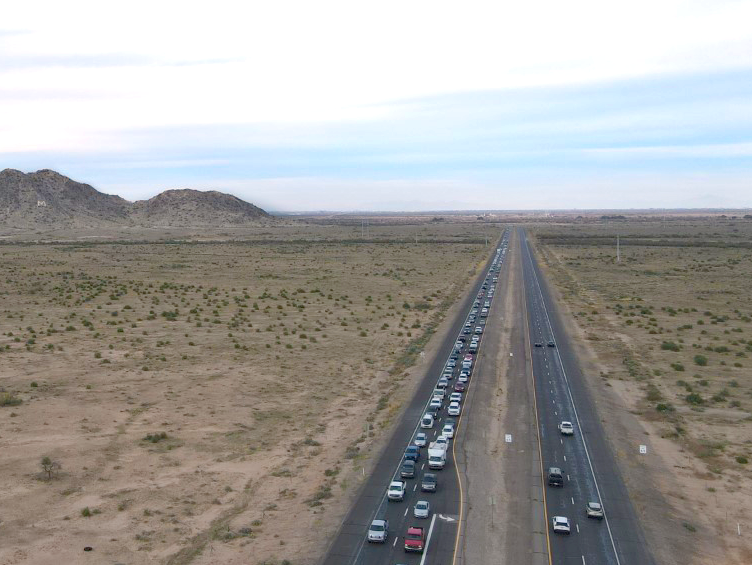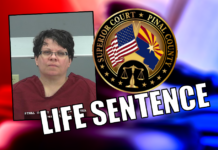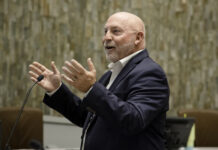A recent poll conducted by Public Opinion Strategies, a national political and public affairs survey research firm, found Pinal County residents overwhelmingly support another version of the half-cent sales transportation tax ruled unconstitutional in March.
According to Glen Bolger, the firm’s partner and co‑founder, the public is willing to tax itself to fund long-term transportation solutions.
“Pinal County is poised to vote again, by larger than in 2017, for Propositions 416 and 417,” Bolger said on a recent Zoom call with members of the Pinal Regional Transport Authority.
Proposition 416 was the measure that outlined the county’s long-range transportation plan, and 417 was the tax-funding measure. The tax was found to be unconstitutional by the Arizona Supreme Court because it was two-tiered, with only the first $10,000 of any transaction being taxed and the rest exempted.
Bolger indicated the early support for the tax is not surprising.
“Support for taxes always polls better in the beginning, when it is more theoretical than actual, so expect the final ballot to not be as high as it was in the survey,” he told PRTA members at last month’s virtual meeting. “And remember, undecideds vote no on propositions, especially those involving taxes.”
Even with those facts, Bolger said the tax has an advantage because people have been paying it for the past four years, making it easier for them to support it again, especially since it is targeted for already defined and freeway projects. Those projects include widening State Route 347 from Maricopa to Interstate 10; building the Sonoran Desert Parkway on the south side of Maricopa from SR 347 to I-10; widening I-10 to three lanes from the Valley to Casa Grande; and moving forward on the development of I-11.
The propositions do well across party lines with Democrats the most supportive – but most Republicans and Independents back them as well. There are modest differences by ethnicity, region of the county and gender/age on both propositions, but those differences are not significant to targeting.
Bolger said his company only tested one message, but the results were off the charts.
“Fully 86% agree, including 58% strongly, that traffic has only gotten worse since voters approved the tax,” he said. “We need new roads and freeways now, and it does not mean new taxes since the tax has been collected the last four years. That is a succinct message that we need to focus on, along with the need to vote yes on both to get the new roads and freeways built.”
The Alexandria, Virginia firm polled 300 likely Pinal County voters from March 12-15, and the poll had a margin of error of 5.66%.
In the most telling responses, poll subjects were asked the question, “Just recently the Arizona State Supreme Court invalidated parts of Propositions 416 and 417, stopping the collection of the tax and ending funding for the construction of new roads and freeways in Pinal County. If the county fixes the technical issue that caused the state Supreme Court to invalidate the Propositions and the two Propositions are placed on the ballot once again for Pinal County residents to vote on in November 2022, would you vote yes or no on the two propositions?”
More than two-thirds of those polled said yes – 33% definitely and 35% probably. Only 18 percent said no, with 8% of those a “definite no.” Thirteen percent did not know.
Among Democrats asked that question, 82% were in the yes column while 63% of Republicans answered affirmatively, as did 60% of Independents.
Separately, the regional transportation plan, or Prop 416, looks to be favored by 80% of those polled. Proposition 417, the actual tax itself, showed just over two-thirds still support it with 41% saying they definitely would vote yes, and 26% probably yes. Fewer than one in three would oppose the tax, with 17% “definitely opposing” and 12% “opposing.”
Men are slightly more likely than women to support the tax, with 73% of men 18-54 in favor compared to 65% of women in that age bracket. In the 55+ age bracket, the tax is supported 71% of men and 61% of women.
As with the plan itself, those who agree traffic has gotten worse support the tax at a higher rate. Those who strongly agree about traffic being worse support the tax by 80% to 17%; those who somewhat agree support it 66% to 31%; and those who disagree with the statement oppose the tax by a whopping 86% to 11%.
Bolger identified a potential strategy for those opposing the tax in the coming election.
“The way opponents will try to defeat this is to claim the money is going into a black box and spent on government perks and privileges, like fancy offices and pay raises,” he said. “We did not test it, but it would be good to point to roads and freeways built or under construction using the 416/417 money, to prove that the money is going where intended.”








![MHS G.O.A.T. a ‘rookie sleeper’ in NFL draft Arizona Wildcats wide receiver Jacob Cowing speaks to the press after a practice Aug. 11, 2023. [Bryan Mordt]](https://www.inmaricopa.com/wp-content/uploads/2024/04/cowing-overlay-3-218x150.png)




![Alleged car thief released without charges Phoenix police stop a stolen vehicle on April 20, 2024. [Facebook]](https://www.inmaricopa.com/wp-content/uploads/2024/04/IMG_5040-218x150.jpg)




